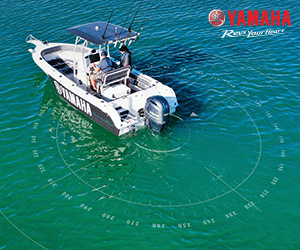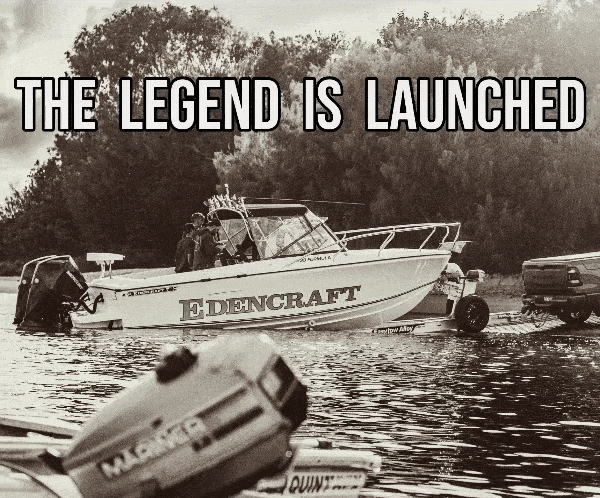Reef Therapy – Dan Bowater July 16
About ten years ago I was involved in one of those special trips that totally changed my level of appreciation for fishing on the reef. Our crew consisting of fellow Fish and Boat writer Steve Polzin, his mate Paul Tucalz, and I set out with the intention of fishing a big overnighter that would probably involve several hours of mixed action.
Little did we know that within a mere few hours we would all be packed up back at the ramp. The first two drops resulted in a stunning 6kg red emperor and large mouth nannygai. Then for an hour came a steady procession of similar quality reef captures until the 110L esky was packed full to the brim with a dozen prime table fish. All were high quality, featuring trademark aggressive mannerisms and beautiful bright colouration. It was inspiring stuff! For me I really couldn’t fathom what was unfolding. However, it was the reaction from the other guys that left a more substantial impression. Everything just seemed to effortlessly fall into place. In fact the more silly we behaved somehow the better the fishing became! During the session we were graced by the sight of a massive rising moon that left a subtle glow over the glassed out ocean. I remember Paul pausing to ask us very candidly “don’t you think this is paradise?” Well Steve and I just couldn’t disagree!
Since this time we have fondly viewed reef fishing as something more like ‘reef therapy’. It’s sort of like an unexplainable nourishment of the mind and soul. Most experienced northerners however are well aware that our part of Queensland can be anything but the paradise it is commonly labelled. By nature FNQ tends to show more extremes compared to the more temperate and populated south east. Oppressive heat/humidity, howling winter trade winds and torrential rainfall all take their collective toll often cancelling long awaited trips. Problematically for offshore punters the dry mid-year sou ‘east trade winds tend to intensify for long spells only occasionally abating usually when work commitments interfere. By the same token it doesn’t take much for things to change drastically for the better. At the time of writing a huge low pressure system recently sucked all the bad weather to the southern states who endured record floods and storm damage. I guess we are the beneficiaries of the weather gods this time. During the first weekend of June I met Steve Polzin in Cairns for a well overdue day of ‘reef therapy’.
On exiting the Trinity Inlet in Steve’s 625 Cruise craft it was destined to be one of those cherished magic days on the water signified by a layer of fog blanketed over the CBD. In the pre-dawn darkness the fog had entrapped and illuminated the city lights but it was clearer and noticeably warmer on the water. It was one of those rare experiences you can only get on a fishing trip. Maybe it was an omen? There’s certainly a special feeling knowing the whole town is still sound asleep while you are equipped and descending upon the reef for a great day of fishing. We have found over the years that the reef is almost like a massive chess board and carefully planning your anticipated moves helps not only save fuel but provide realistic back up options in case things start going pear shaped. For this reason we focused on an area that held a range of depth options and habitats within a small radius. Our game plan was to begin fishing in sixty metres for our main target species (red emperor and large mouth nannygai) then move into 20-30m for a shot at some silver podium trout and pelagic species. We sometimes call it “taking fruit off each tree”.
Many of the Cairns boating fraternity focus their bottom bashing efforts on the primary reefs but rarely would this be a first option for us especially when reds are involved. Finding ground that is separated from the more obvious structure isn’t always easy but it’s certainly worth scoping out with a spread of lures out the back. That’s precisely how Steve located our patch of isolated bommies, which due to low pressure, are home to a good number of sizeable reef dwellers. The fishing is much easier than the finding! Like many anglers discovered in the lead up to June, the Lund’s brand of Californian squid started to disappear off the market apparently due to the effects of El Niño changing the squid’s normal movements and reproduction. Whatever the reason there was suddenly a surge of over-demand (and still is!). We managed to grab a couple of boxes just before they vanished from freezers, and these tasty morsels are generally the ticket to hooking the better deepwater species. Once we got our anchoring sorted we got to business each sending down a pair of squid baits down on eight ounce leads. When a massive sea snake appeared on the surface Steve believed we had found the spot (apparently some pro anglers use this as a sign of good fish holding structure below). The sounder seemed to show very inconsistent shows, with the display lighting up for a few seconds then turning totally barren. With hardly any tidal movement we eventually realised the fish were roaming around the patch of bommies rather than hanging tight. This peculiarity made me realise that finding the right bottom structure can be more critical than interpreting shows during slack water.
My first drop took only a few seconds the get smashed but I was amazed to pull up a doggy mackerel and hussar double. I never thought doggies went that far down! For a second I was cursing the dud drop until I realised both species would be potentially perfect alternate baits to the frozen supply. The hussar especially has a strong reputation as a big red taker when its fillet is cut with bright yellow tail attached. The bait is hooked once only (through the flesh and out of the skin). This style of presentation prevents the hook from burying in the bait and also causes a wafting effect when it’s in the zone. In contrast we like the smaller Lund’s squid for the nannygai, but they weren’t exactly jumping aboard like normal. We tried for an hour with only a couple of average nannygai for the scoreboard. I find reducing leader thickness and even hook size can really help turn things around if the action tapers off. Lately another trick I’ve enjoyed involves preparing a few different fluorocarbon dropper rigs. It is more expensive compared to normal soft mono but I’ve found less become damaged or busted off due to the low stretch and high abrasion resistance qualities. It was at that point when I remembered the doggy mack we threw in the ice box. Their oily flesh is ideal for enticing tough bites and their leathery skin tends to hold well against pickers. We also remembered that a tide change was about to occur. I duly sent down a pair of doggy mack cut baits on a new fluorocarbon dropper rig. At the same time I observed a suggestive cloud of arches moving low on the Furuno sounder. The unmistakable thud-like bites of a good nanny echoed through the braid upon touching bottom- a good fishing period seemed imminent! When I set the hooks I could also hear some struggling movements behind me as Steve got stuck into another good nanny. For about twenty minutes every doggy mack cube was chewed up with several lovely nannygai boated. It’s probably the only time I’ve seen them turn down squid in favour of different bait! Despite some harrowing deepwater fights things were still kept civilised by the crisp/clear winter conditions. Among the nannygai we found action with other species such as cobia and green jobfish- both perfect eating sizes at around six kilos apiece.
During mid-morning the big plough was swapped for a traditional reef anchor and we followed our plan of hop-scotching our way into lower depth ranges. We sent down some pillies to the bottom and Steve instantly had his bait walloped by a stonker trout. It measured 70cm and was almost square shaped- one of the biggest I had seen! However on my side of the boat I could only feel annoying taps from fusiliers and eventually one of the little buggers hooked itself. Half way to the surface things went disturbingly light due to a suspected mackerel ‘drive by attack’ on such easy prey. I detached the half eaten ‘fuzie’ and snipped off my dropper rig in favour of a sabiki style bait jig. Now I actually wanted to catch one! Before long I had an unmolested fusilier live bait safely onboard then deployed four meters under a balloon. My mack outfit barely entered the rod holder before it was annihilated in no uncertain fashion. The opening run saw about 80 odd meters of 15kg mono melt at warp speed to the horizon. Then things became a bit more like a stalemate, with the fish not budging for several minutes. We both figured I had hooked a ‘grey suit’ as these shallow reefs were notorious for small 5-8 foot long whaler sharks. When they dig their heels in, the fights become very tedious…but it always pays to see colour first! We patiently waited out the fight with the fish slowly surrendering near the surface. Finally we saw a sizeable shape appear. We couldn’t quite make it out “cobia…no shark! no G.T!” Then a silver train shaped reflection made the extra wait seem worthwhile as an imposing Spanish mackerel arced just out of gaffing range. My wire trace had pinned it just behind the eye, thus causing the mack to fight using more surface area than normal.
Once acquainted with this mighty 16kg fish we were stunned to get our final target species in such a crazy sequence of events. We could still see huge arches passing through the Furuno so Steve quickly set up a drifting pillie in one final throw of the dice. It was a quicker option than going through the rigmarole of catching another fusilier. Again, the bait was monstered in seconds with a smoking opening run on the Saltiga suggesting a possibly bigger Spanish mack. All indications were indeed of a great fish with repeated surface runs tearing 40lb braid at will. The heavier gear and a bit of good technique helped work this big ‘mackie’ back to the boat. Then the unthinkable happened. Just out of view a pack of whaler sharks closed in and mauled Steve’s impeding trophy capture. We at least got the head back- that weighed 7kg on its own!
It still was hard to be disappointed when realising the results from our early winter reef expedition. Every location we visited produced the quality action on the species we desired! From my perspective this well-planned trip felt so much like the great overnighter I described from ten years ago. I think generally in fishing people commonly look for quick/easy ways of getting into the action whether that’s taking someone else’s GPS marks or just buying new gear etc. The reality is that even successful reef trips do require some careful planning and groundwork. The common saying is ‘10% of anglers catch 90% of fish’ and I’d agree wholeheartedly. It’s interesting to note how guys like Steve have done so well as they realise the continuity of the learning process rather than viewing fishing like an oversimplified smash n’ grab activity. I even think there’s a bit of a class struggle in fishing knowledge sort of like in society where the divide between rich and poor slowly widens. The guys who stick with the pastime and evolve with it keep jumping way ahead of the pack.
Paradoxically over time I’ve also realised that planning in a way that makes things physically easy really helps. For example our strategy of fishing multiple depths up to 60m plus isn’t one I’d support over the summer months unless perhaps after dark. When we fish in a way that works within our capabilities it makes each trip seem more special. Of course when the fish also play the game it just makes the experience feel effortless and all the more captivating. The transitional weather months from April-June and August-October really see the best opportunities for outdoor living in FNQ. Making the absolute most of the limited chances arising during these periods is, in my view, a major factor in breaking through as a northern angler. So this winter keep an eye on your weather forecasts, get a solid game plan together, get out there and enjoy the tasty fruits of our reef paradise!
If you’d like to view some recent GoPro footage from my Cairns reef fishing trips go to FishandBoatTube and view the below links:
http://www.fishandboattube.com.au/media-gallery/800-mack
http://www.fishandboattube.com.au/media-gallery/780-nannygai-bite





